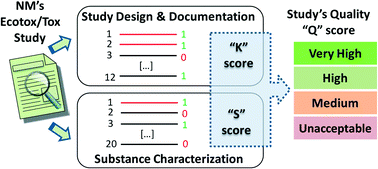当前位置:
X-MOL 学术
›
Environ. Sci.: Nano
›
论文详情
Our official English website, www.x-mol.net, welcomes your feedback! (Note: you will need to create a separate account there.)
Quality evaluation of human and environmental toxicity studies performed with nanomaterials – the GUIDEnano approach
Environmental Science: Nano ( IF 7.3 ) Pub Date : 2017-12-06 00:00:00 , DOI: 10.1039/c7en00716g M. L. Fernández-Cruz 1, 2, 3 , D. Hernández-Moreno 1, 2, 3 , J. Catalán 4, 5, 6, 7, 8 , R. K. Cross 9, 10, 11, 12 , H. Stockmann-Juvala 4, 5, 6, 7, 8 , J. Cabellos 3, 13, 14 , Viviana R. Lopes 15, 16, 17, 18, 19 , M. Matzke 12, 20, 21 , N. Ferraz 15, 16, 17, 18, 19 , J. J. Izquierdo 1, 2, 3 , J. M. Navas 1, 2, 3 , M. Park 22, 23, 24 , C. Svendsen 12, 20, 21 , G. Janer 3, 13, 14
Environmental Science: Nano ( IF 7.3 ) Pub Date : 2017-12-06 00:00:00 , DOI: 10.1039/c7en00716g M. L. Fernández-Cruz 1, 2, 3 , D. Hernández-Moreno 1, 2, 3 , J. Catalán 4, 5, 6, 7, 8 , R. K. Cross 9, 10, 11, 12 , H. Stockmann-Juvala 4, 5, 6, 7, 8 , J. Cabellos 3, 13, 14 , Viviana R. Lopes 15, 16, 17, 18, 19 , M. Matzke 12, 20, 21 , N. Ferraz 15, 16, 17, 18, 19 , J. J. Izquierdo 1, 2, 3 , J. M. Navas 1, 2, 3 , M. Park 22, 23, 24 , C. Svendsen 12, 20, 21 , G. Janer 3, 13, 14
Affiliation

|
The European Union FP-7 project GUIDEnano developed a web-based guidance tool, which guides users to assess human and environmental risks of nanomaterial-enabled products throughout their life cycle. One of the aims in the GUIDEnano hazard assessment strategy is to derive safety limit values based on existing human toxicity and ecotoxicological studies. Clear criteria needed to be established to select studies that could be used for such purpose. In the present paper, we present an approach for a systematical and quantitative evaluation of the quality of environmental and human toxicity studies performed with nanomaterials. The approach builds upon previous initiatives and includes refinements to facilitate its application by users with limited toxicological expertise. It covers in vivo and in vitro human toxicity studies as well as ecotoxicological studies addressing the toxicity to all environmental compartments. A scoring system related to test design and reporting considerations was developed following the principles of the Klimisch score (K score). In addition, the approach includes a scoring system based on the physicochemical properties that have been characterized and reported for the nanomaterial, including properties characterized in the exposure medium (S score). These two scores (K and S) are combined to obtain an overall quality score (Q score) that can be used to select studies, to weight different studies, and/or to introduce uncertainty factors in the risk assessment process. During its development, the approach has been tested and refined with 137 peer-reviewed articles. The final quality assessment approach and the results of its evaluation are presented here.
中文翻译:

使用纳米材料进行的人类和环境毒性研究的质量评估-GUIDEnano方法
欧盟FP-7项目GUIDEnano开发了一个基于Web的指导工具,该工具可指导用户评估在其整个生命周期中启用纳米材料的产品的人类和环境风险。GUIDEnano危害评估策略的目标之一是根据现有的人类毒性和生态毒理学研究得出安全极限值。需要建立明确的标准来选择可用于此目的的研究。在本文中,我们提出了一种系统和定量评估使用纳米材料进行的环境和人类毒性研究质量的方法。该方法以先前的举措为基础,并进行了改进,以促进毒理学专业知识有限的用户使用它。它涵盖了体内和体外人类毒性研究以及针对所有环境部分的毒性的生态毒理研究。遵循Klimisch评分(K评分)的原则,开发了与测试设计和报告注意事项相关的评分系统。另外,该方法包括基于已表征和报道的纳米材料的物理化学性质的评分系统,包括在曝光介质中表征的性质(S评分)。将这两个分数(K和S)组合在一起可获得总体质量分数(Q分数),可用于选择研究,对不同的研究进行加权和/或在风险评估过程中引入不确定性因素。在其开发过程中,已对该方法进行了137次同行评审文章的测试和完善。
更新日期:2017-12-06
中文翻译:

使用纳米材料进行的人类和环境毒性研究的质量评估-GUIDEnano方法
欧盟FP-7项目GUIDEnano开发了一个基于Web的指导工具,该工具可指导用户评估在其整个生命周期中启用纳米材料的产品的人类和环境风险。GUIDEnano危害评估策略的目标之一是根据现有的人类毒性和生态毒理学研究得出安全极限值。需要建立明确的标准来选择可用于此目的的研究。在本文中,我们提出了一种系统和定量评估使用纳米材料进行的环境和人类毒性研究质量的方法。该方法以先前的举措为基础,并进行了改进,以促进毒理学专业知识有限的用户使用它。它涵盖了体内和体外人类毒性研究以及针对所有环境部分的毒性的生态毒理研究。遵循Klimisch评分(K评分)的原则,开发了与测试设计和报告注意事项相关的评分系统。另外,该方法包括基于已表征和报道的纳米材料的物理化学性质的评分系统,包括在曝光介质中表征的性质(S评分)。将这两个分数(K和S)组合在一起可获得总体质量分数(Q分数),可用于选择研究,对不同的研究进行加权和/或在风险评估过程中引入不确定性因素。在其开发过程中,已对该方法进行了137次同行评审文章的测试和完善。



























 京公网安备 11010802027423号
京公网安备 11010802027423号